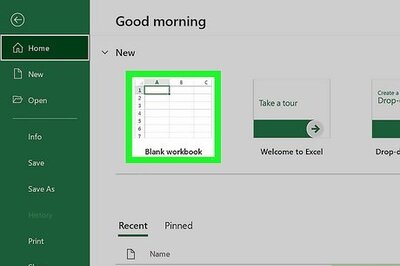
views
What does “With that being said” mean?
“With that being said” is a transitional phrase that introduces a new or contrasting idea. It’s similar to saying “however” or “despite what I just said” to suggest that your next thought will go against the expectations you set up in your first thought or point. “With that being said” implies that both opposing thoughts are true and valid from your point of view. “I don’t have a huge sweet tooth. With that being said, I do really love cheesecake though!” “Marcy is a fabulous student overall. With that being said, I am a bit concerned about her math skills.” Tip: "With that being said" is different from the phrase "enough said," which means it's time to stop talking about a topic because no further information is needed.
When & How to Use “With That Being Said”
Say “With that being said” to connect two ideas that seem contradictory. With this structure, the second thought or sentence goes against the expectations set up by the first thought or sentence to show that two opposing or contrasting points can be true at once. For example, you could highlight an employee’s good work in the first sentence, but then explain that they did not get a promotion in the second sentence: “Your work is consistently high-quality. With that being said, we’re unable to offer you a promotion at this time.” Both ideas here are true—the employee does good work, but they still aren’t getting promoted. “My daughter is afraid of dogs after she got bitten last year. With that being said, she sure has a soft spot for your pug!” “I’m a horrible cook and burn just about everything I try to make. With that being said, I do make a mean ice cream sundae!”
Or, use “With that being said” to show how your second thought is a continuation of the first. Less often, “With that being said” can be a signal to listeners that everything you just said logically leads to what you’ll say next (technically, there’s nothing about this phrase that indicates it must lead to a contrasting thought). For example, after listing the great leadership qualities of a person, you might say “...With all that being said, I think they’d be a great mayor!” In this case, you’re following through on the expectation you built with your first thought; why wouldn’t someone who’s a good leader make a good mayor? “I’ve always loved hiking and nature. With that being said, it’s probably not a shock that I moved closer to the mountains!” “It looks like we’ve already booked the venue, printed the programs, and signed the contract with the caterer. With that being said, I think we’re ready for the event!”
Use “With that being said” to transition to a new speaker or event. If you’re introducing another speaker, providing a welcome message, or offering background information before an event begins, say “With that being said” to signal that you’re wrapping up your thoughts and are about to introduce the next thing. This lets listeners know you’re about to be finished and shifts their attention to who or what is coming next. “Thank you all so much for coming to our movie screening today! I know the commute wasn’t easy in this rain and we really appreciate it. With that being said, let’s jump right into the film!” “Welcome everyone! I have a few announcements before the show begins. Emergency exits are located behind you and bathrooms are available on the first floor. Feel free to grab a drink at the bar anytime since there is no intermission. With that being said, make some noise for your first performer, Caroline!”
Similar Phrases & Synonyms for “With That Being Said”
There are many other ways to say “With that being said.” Depending on the context, you may want to use a phrase that’s shorter, more formal, or more specific to transition between ideas. Here are more ways to convey how your points are connected: Short phrases: Use “but,” “however,” or “regardless” for a short, simple alternative in casual or formal settings. These words imply your second thought will contrast from the first. Synonym phrases: “Having said that,” “that being said,” “with that said,” and “that said” are all grammatically correct ways to phrase “with that being said.” These are all semi-formal, with “that said” being the least formal. “Despite” phrases: Use “despite” to specifically name a fact or point from your first thought to highlight how it relates to or contrasts with the second. For example: “Despite everything I’ve just said…” “Despite the evidence the prosecution showed the jury…” “Despite the horrible weather…”
Is “With that being said” a formal phrase?
“With that being said” is usually considered semi-formal. It’s a common English phrase that doesn’t sound overly casual or super formal and is suitable for a lot of different scenarios in friendly conversation, professional settings, and emails. You may be more likely to hear it in speeches or presentations than in organic conversation, which gives it a slightly more formal sound. In everyday conversation, transition words like “however” or “but” are more common and casual than “with that being said” and may sound more natural. “That said” is a shorter, slightly more casual way to say “With that being said” in both personal or professional settings.

















Comments
0 comment